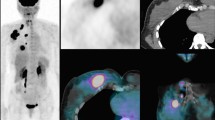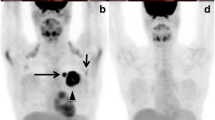Abstract
The purpose of this study is to determine the incidence of primary breast cancer (PBC) detected on (18) F-fluorodeoxyglucose (FDG) positron emission tomography (PET)–computed tomography (CT) in patients with a known diagnosis of non-mammary malignancies. A database search was performed to identify patients with non-mammary malignancies who had undergone staging with FDG PET–CT at a single institution between September 2005 and September 2011 and with the word “breast” reported in the PET–CT dictation. Additional breast imaging studies, clinical data, and the final histopathology of the breast lesions were correlated with the PET–CT images. Of 1951 patients who underwent PET/CT, 440 incidental breast lesions were identified in 438 patients. Of these 440 lesions, 195 (45 %) were benign, 160 (37 %) malignant, and 85 (19 %) missing data. A total of 25 PBCs were diagnosed; with a median size of 1.8 cm (range 0.8–10.7 cm); and a median SUVmax of 4.4 (range 1.7–17.6). There were 19 invasive ductal cancers, 1 invasive lobular cancer, 2 papillary cancers, 1 tubular cancer, 1 sarcomatoid cancer, and 1 ductal carcinoma in situ. Eight patients had regional nodal disease. Mammography revealed the PBC in 19 of 23 tumors (83 %), sonography in 22 of 23 (96 %). Six percent (25 of 440) of incidental breast lesions identified on FDG PET–CT represent PBCs; more than half were at an early stage and potentially curable.


Similar content being viewed by others
References
Avril N et al (2000) Breast imaging with positron emission tomography and fluorine-18 fluorodeoxyglucose: use and limitations. J Clin Oncol 18(20):3495–3502
Bar-Shalom R, Valdivia AY, Blaufox MD (2000) PET imaging in oncology. Semin Nucl Med 30(3):150–185
Bohuslavizki KH et al (2000) FDG PET detection of unknown primary tumors. J Nucl Med 41(5):816–822
Eubank WB, Mankoff DA (2005) Evolving role of positron emission tomography in breast cancer imaging. Semin Nucl Med 35(2):84–99
Kostakoglu L, Agress H Jr, Goldsmith SJ (2003) Clinical role of FDG PET in evaluation of cancer patients. Radiographics 23(2):315–340
Shen YY et al (2003) The value of 18F-fluorodeoxyglucose positron emission tomography with the additional help of tumor markers in cancer screening. Neoplasma 50(3):217–221
Yasuda S et al (2000) Application of positron emission tomography imaging to cancer screening. Br J Cancer 83(12):1607–1611
Dong C, Hemminki K (2001) Second primary neoplasms among 53 159 haematolymphoproliferative malignancy patients in Sweden, 1958–1996: a search for common mechanisms. Br J Cancer 85(7):997–1005
Ishimori T, Patel PV, Wahl RL (2005) Detection of unexpected additional primary malignancies with PET/CT. J Nucl Med 46(5):752–757
Ueno M et al (2003) Multiple primary cancer: an experience at the Cancer Institute Hospital with special reference to colorectal cancer. Int J Clin Oncol 8(3):162–167
Sickles E, D’Orsi CJ, Bassett LW et al (2013) ACR BI-RADS® Mammography. ACR BI-RADS® atlas, breast imaging reporting and data system. American College of Radiology, Washington, DC
Mendelson EB, Böhm-Vélez M, Berg WA et al (2013) ACR BI-RADS® ultrasound. ACR BI-RADS® atlas, breast imaging reporting and data system. American College of Radiology, Reston
Morris EA, Comstock CE, Lee CH et al (2013) ACR BI-RADS® Magnetic Resonance Imaging. Atlas, Breast Imaging Reporting and Data System. American College of Radiology, Reston
Kumar R et al (2006) Standardized uptake values of normal breast tissue with 2-deoxy-2-[F-18]fluoro-d: -glucose positron emission tomography: variations with age, breast density, and menopausal status. Mol Imaging Biol 8(6):355–362
Lin CY et al (2007) Correlation between the intensity of breast FDG uptake and menstrual cycle. Acad Radiol 14(8):940–944
Vranjesevic D et al (2003) Relationship between 18F-FDG uptake and breast density in women with normal breast tissue. J Nucl Med 44(8):1238–1242
Harish MG et al (2007) Breast lesions incidentally detected with CT: what the general radiologist needs to know. Radiographics 27(Suppl 1):S37–S51
Korn RL et al (2006) Unexpected focal hypermetabolic activity in the breast: significance in patients undergoing 18F-FDG PET/CT. AJR Am J Roentgenol 187(1):81–85
McDonough MD, DePeri ER, Mincey BA (2004) The role of positron emission tomographic imaging in breast cancer. Curr Oncol Rep 6(1):62–68
Henschke CI et al (2006) Survival of patients with stage I lung cancer detected on CT screening. N Engl J Med 355(17):1763–1771
Avril N (2007) Adler LP, F-18 fluorodeoxyglucose-positron emission tomography imaging for primary breast cancer and loco-regional staging. Radiol Clin North Am 45(4):645–657
Rosé C, Dose J, Avril N (2002) Positron emission tomography for the diagnosis of breast cancer. Nucl Med Commun 23:613–618
Schilling K et al (2011) Positron emission mammography in breast cancer presurgical planning: comparisons with magnetic resonance imaging. Eur J Nucl Med Mol Imaging 38(1):23–36
Weinberg IN et al (2005) Positron emission mammography: high-resolution biochemical breast imaging. Technol Cancer Res Treat 4(1):55–60
Berg WA et al (2006) High-resolution fluorodeoxyglucose positron emission tomography with compression (“positron emission mammography”) is highly accurate in depicting primary breast cancer. Breast J 12(4):309–323
Brem RF et al (2007) Breast-specific gamma imaging with 99mTc-Sestamibi and magnetic resonance imaging in the diagnosis of breast cancer–a comparative study. Breast J 13(5):465–469
Disclosure
Benveniste AP, MD, Marom EM, MD, Benveniste MF, MD, Mawlawi O, PhD have nothing to disclose. Fox PS, MS—NCI Grant to Institution. Yang WT, MD—Toshiba/Seno Medical [Consultant/Advisory].
Author information
Authors and Affiliations
Corresponding author
Rights and permissions
About this article
Cite this article
Benveniste, A.P., Marom, E.M., Benveniste, M.F. et al. Incidental primary breast cancer detected on PET–CT. Breast Cancer Res Treat 151, 261–268 (2015). https://doi.org/10.1007/s10549-015-3402-7
Received:
Accepted:
Published:
Issue Date:
DOI: https://doi.org/10.1007/s10549-015-3402-7




